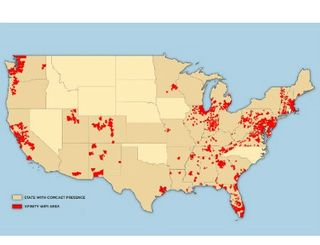Cable Show: Comcast Going Big With WiFi

Using a mix of quasi-public hotspots deployed in outdoor locations, businesses and on customer-side DOCSIS gateways, Comcast said its WiFi network will span 8 million hotspots by the end of the year.
Comcast, which announced it had surpassed the 1 million mark earlier this month, said it will be boosting that number throughout the year by deploying hotspots in several markets, including Atlanta, Baltimore, Boston, Chicago, Denver, Detroit, Hartford, Houston, Indianapolis, Miami, Minneapolis, Nashville, Philadelphia, Pittsburgh, Portland, Sacramento, Salt Lake City, San Francisco, Seattle, and Washington D.C.
Usage is also on the rise. Comcast said nearly 200 million out-of-home sessions have been initiated on its WiFi network so far this year, a 700% increase versus the same period last year.
“Wireless access is increasingly important to our customers, and we are building a network that not only meets today’s needs but also stays ahead of tomorrow’s demands,” Marcien Jenckes, executive vice president of consumer services for Comcast Cable, said in a statement. “Xfinity WiFi is a reliable, fast resource for millions of customers who want access to the Internet, anytime, anywhere. We’ll add millions more hotspots this year in the places where our customers live and work.”
Comcast does not break down how many hotspots it has deployed outdoors, at business location and by the lighting up a second "xfinitywifi” SSID signal on DOCSIS-powered Xfinity Wireless Gateways in customer homes. Regarding the latter, Comcast said about 54% of Xfinity’s “neighborhood” WiFi usage travels over the second SSID.
MSO members of the “Cable WiFi” roaming alliance (Comcast, Time Warner Cable, Cablevision Systems, Cox Communications and Bright House Networks) announced Monday that they had collectively deployed more than 250,000 hotspots.
Although there are indications that these MSOs might use their growing wireless broadband networks to support a “WiFi First” approach that uses cellular mobile networks as a fallback, they are using it today primarily as a value add for cable-modem subscribers who need broadband connectivity on the go.
Multichannel Newsletter
The smarter way to stay on top of the multichannel video marketplace. Sign up below.
